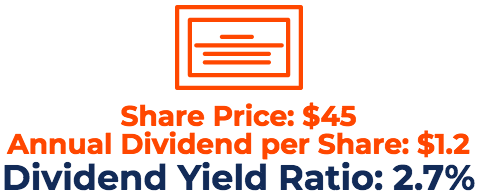Dividend Yield Formula
A financial ratio that measures the amount of dividends relative to the market value per share
What is Dividend Yield?
The Dividend Yield is a financial ratio that measures the annual value of dividends received relative to the market value per share of a security. In other words, the dividend yield formula calculates the percentage of a company’s market price of a share that is paid to shareholders in the form of dividends.

Dividend Yield Formula
The dividend yield formula is as follows:
Dividend Yield = Dividend per share / Market value per share
Where:
- Dividend per share is the company’s total annual dividend payment, divided by the total number of shares outstanding
- Market value per share is the current share price of the company
Practical Example
Company A trades at a price of $45. Over the course of one year, the company paid consistent quarterly dividends of $0.30 per share. The dividend yield ratio for Company A is calculated as follows:
Dividend Yield Ratio = ($0.30 + $0.30 + $0.30 + $0.30) / $45 = 0.02666 = 2.7%
The dividend yield ratio for Company A is 2.7%. Therefore, an investor would earn 2.7% on shares of Company A in the form of dividends.
Dividend Yield Ratio Across Industries
The comparison of dividend yield ratios should only be done for companies operating in the same industry – average yields vary significantly between industries. The average dividend yield for several industries is as follows:
- Basic materials industry: 4.92%
- Financial services industry: 4.17%
- Healthcare industry: 2.28%
- Industrial industry: 1.76%
- Services industry: 2.37%
- Technology industry: 3.2%
- Utility industry: 3.96%
Dividend Yield Formula Among Companies
The following is information related to Company A and Company B for FY 2018:

Both companies operate in the same industry. However, Company A entered the marketplace a long time ago, while Company B is a relatively new company. One of your friends, John, is looking to invest in a company with a good dividend payout. Which will you recommend to John – Company A or Company B?

The dividend yield ratio for each company is calculated as follows:
Company A:
= $7.08 / $29.00 = 0.24413 = 24.413%
Company B:
= $3.17 / $31.00 = 0.10226 = 10.226%
Note: The dividend attributed to each share is simply the total dividend declared divided by the number of weighted average shares outstanding.
In this case, we can see that Company A is a more attractive option for John. Company A is an older and more established company that is able to sustain a stable dividend distribution to its investors. Company A is a more reliable and less risky company, as compared to Company B.
Interpretation of Dividend Yield Formula
The dividend yield formula is used to determine the cash flows attributed to an investor from owning stocks or shares in a company. Therefore, the ratio shows the percentage of dividends for every dollar of stock.
A high or low yield depends on factors such as the industry and the business life cycle of the company. For example, it may be in the best interest of a fast-growing company to not pay any dividends. The money might be better used by reinvesting into the company to grow the business.
On the other hand, a mature company may report a high yield due to a relative lack of future high growth potential. Therefore, the yield ratio does not necessarily indicate a good or bad company. Rather, the ratio is used by investors to determine which stocks align with their investment strategy.
Other Resources
Thank you for reading CFI’s guide to Dividend Yield Formula. To help you advance your career in the financial services industry, check out the following additional CFI resources: